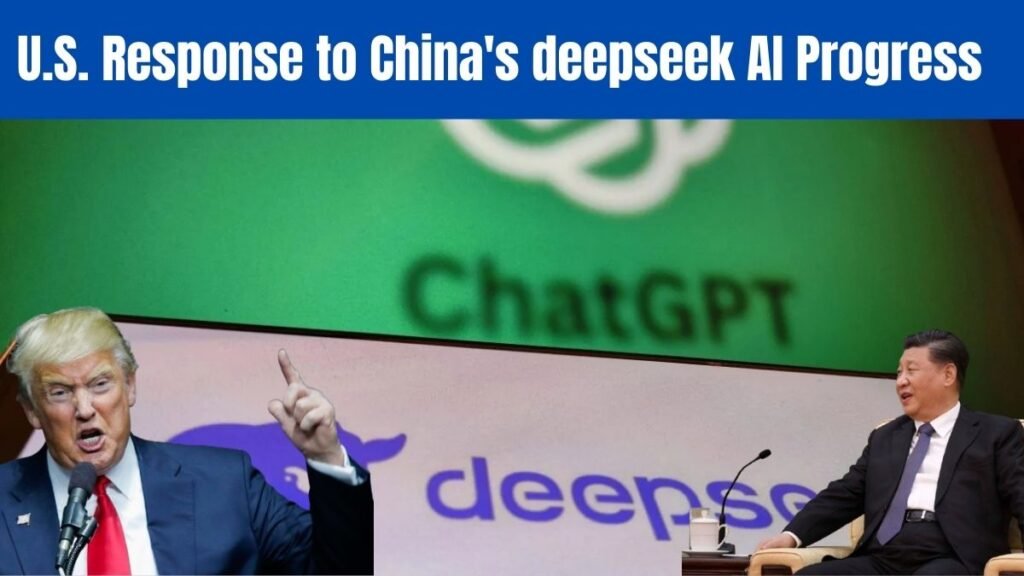The rise of DeepSeek AI, a cutting-edge Chinese artificial intelligence company, has sent shockwaves through the global AI industry. With its rapid advancements and cost-effective development, DeepSeek is emerging as a formidable competitor to American AI giants like OpenAI and Google DeepMind. The U.S. government, recognizing the urgency of maintaining technological leadership, has responded decisively. President Donald Trump has signed an executive order to accelerate AI innovation and ensure America’s continued dominance in this crucial field.
This article explores DeepSeek’s rise, its impact on U.S. AI competitiveness, and how the U.S. government and tech industry are responding to this growing challenge.
DeepSeek AI: A New Challenger in the AI Race
DeepSeek AI, a relatively new player in the artificial intelligence sector, has developed an advanced open-source AI model known as DeepSeek R1. Unlike many Western AI models, which require vast computational resources, DeepSeek has focused on efficiency and cost reduction, making AI more accessible and scalable.
Key Features of DeepSeek AI:
- Mixture-of-Experts (MoE) Architecture: This system activates only specific parts of the model when needed, reducing computational costs.
- FP8 Mixed-Precision Training: Enhances performance while keeping energy consumption low.
- Open-Source Model: Unlike OpenAI’s proprietary approach, DeepSeek has embraced an open-source strategy, allowing developers worldwide to contribute to its growth.
DeepSeek’s breakthroughs have led to speculation that China could soon rival the U.S. in AI innovation, raising alarms among American policymakers and tech leaders.
Trump’s Executive Order: Strengthening U.S. AI Capabilities
In response to DeepSeek’s advancements, President Trump signed an executive order aimed at reinforcing America’s AI leadership. The order directs federal agencies to develop an AI action plan within 180 days, focusing on:
- Reducing Regulatory Barriers: Streamlining policies to accelerate AI development.
- Increasing AI Research Funding: Allocating more resources to cutting-edge AI projects.
- Boosting AI Talent Development: Encouraging AI education and workforce training programs.
- Strengthening AI Security: Implementing measures to prevent foreign adversaries from exploiting U.S. AI advancements.
This move underscores the U.S. government’s determination to prevent China from overtaking its $500 billion AI industry and maintain its technological edge.
How the U.S. Tech Industry is Reacting
DeepSeek’s rise has sparked reactions across Silicon Valley, with major AI companies feeling the pressure to accelerate innovation.
OpenAI’s Response
OpenAI CEO Sam Altman has acknowledged the growing competition and promised to fast-track the release of improved AI models. The company is also exploring new partnerships to maintain its lead in AI development.
Nvidia’s Perspective
As a key supplier of AI chips, Nvidia has recognized China’s increasing demand for AI hardware. The company has emphasized that more of its advanced chips will be required to support AI expansion in both the U.S. and China.
Stock Market Reactions
DeepSeek’s advancements have influenced the stock prices of major AI companies, with some investors concerned about increased competition. However, many experts believe that competition will drive further innovation in the industry.
National Security Concerns and the China Factor
The emergence of DeepSeek has also raised national security concerns in Washington. U.S. lawmakers worry that China’s AI advancements could be used for military applications, surveillance, and influence operations.
Key Security Concerns:
- Data Privacy Risks: The possibility that DeepSeek’s AI models could be used for mass data collection.
- State-Backed AI Development: Unlike U.S. companies, which rely on private funding, China’s AI sector benefits from government subsidies and state-led initiatives.
- Censorship and Propaganda: Concerns that Chinese AI models may be programmed to promote government-approved narratives while suppressing dissenting views.
As a result, U.S. policymakers are exploring stricter export controls on AI technologies and considering new investment restrictions on Chinese AI firms.
The Future of U.S.-China AI Competition
With the global AI race intensifying, the U.S. must continue investing in AI research, infrastructure, and workforce development to maintain its leadership. While DeepSeek’s rise is impressive, the U.S. still holds significant advantages, including:
- A well-established AI ecosystem with leading institutions like MIT and Stanford.
- Access to top AI talent from around the world.
- Strong venture capital investment in AI startups.
The competition between the U.S. and China in AI is far from over. The coming years will determine which nation leads the next wave of AI-driven economic and technological advancements.
Conclusion
DeepSeek AI’s rapid progress has served as a wake-up call for the United States, prompting swift action from both the government and private sector. President Trump’s executive order signals a renewed commitment to AI dominance, ensuring that the U.S. remains a global leader in artificial intelligence.
As the AI arms race between the U.S. and China intensifies, one thing is clear: the future of AI will shape not only technological progress but also economic power, national security, and global influence.
